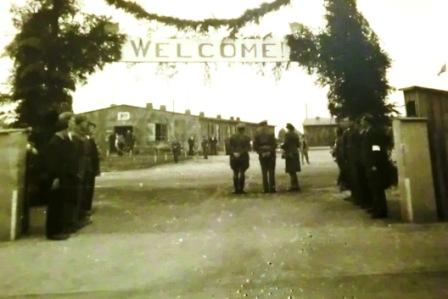August 13, 2017. In researching the history of Camp Ohio, I’m continually amazed at the resilience, optimism, and determination of the residents to organize a community during a period of great uncertainty as to their eventual fate, and when one might expect them to be bitter about the circumstances that led them to be in a displaced persons camp after WWII.

Entrance to Camp Ohio was where the Burgdorf Library is now located. (Photo credit: Taras Schumylowych)
People were not long in the camp before they had opportunities to participate in a variety of activities and voluntary groups. The photos of the Camp Ohio years tell their own unique stories. Camp Ohio had a sports team, youth group, women’s group, literacy classes for adults, an elementary school, churches, choirs, a theatre group, an adult education course, an agricultural school, cooking classes, lectures on cultural topics, and many social occasions such as dances. Baptisms and weddings were celebrated, and funerals were times to support the family left behind.
Many camp residents worked. Some were interpreters for the camp administration, or worked in administration positions themselves. The North German Timber Control company employed loggers to work in the forests, and drivers to take the cut logs to Hannover for shipment to England. There was a medical centre which had nurses, doctors, and dentists, many of them displaced persons. Teachers for the elementary school were camp residents.
It’s a misconception that the displaced persons were all uneducated and poor. It’s true that many were poor and uneducated. Most of the young adults in the camp had their schooling interrupted by WWII. Other younger people had just finished their education before war broke out. However, of the older people, many were professionals. In Camp Ohio, we had a former mayor, a judge, several engineers, a ballet dancer, teachers, a dentist, a Ukrainian Catholic priest, a Ukrainian Orthodox priest, a poultry breeder, an actor, and several farmers.
These professionals were instrumental in helping those less fortunate in the camp, and all residents, no matter their former social standing, were united in the need to educate their children, many of whom had never had a chance to go to school.
After immigrating to new countries from Camp Ohio, the former residents forged successful lives, and their children were able to take advantage of the many educational and professional opportunities available. Among them, one became a psychologist, one a veterinarian, several more engineers, university professors, business people, mechanics, nurses, teachers, and priests. These are just some of the many stories we’ve uncovered over the years about the Camp Ohio residents.
We are lucky that there is a rich archive of photos, taken by residents who had cameras. You may be surprised to know that these amateur photographers traded their cigarette rations to pay for their film and photo developing costs. Residents traded cigarettes in order to get copies of photos, and many have survived.
Can you add to this blog entry about the building a community during the displaced persons camp years? We need your help. If you have any stories, photos, or documents you are willing to share, please send them to dariadv@yahoo.ca to help us increase the archive of information about Camp Ohio and its residents.
© Daria Valkenburg
Pingback: The Agricultural School in Camp Ohio | Camp Ohio Research Project